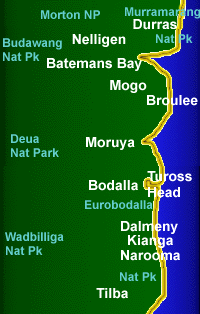Finding a builderIn Chapter 1, we'd found and acquired our lovely block in Lilli Pilli NSW. Step two - find a builder. But first, some new discoveries .... Um, just where was that again?Well, surprise, surprise, when we got our paperwork back from the Eurobodalla Shire Council, we found we were listed as Bunderra Court, Malua Bay - no mention of Lilli Pilli. And after some enquiry, we found it confirmed - our new block was just south of the Lilli Pilli - Malua Bay border, in Malua Bay! The confusion seemed to arise because you access this part of Malua Bay via Lilli Pilli estate. Oh well, we haven't moved - just the border! And so here I am, right back where my parents build their house back in the 1980's. That seems auspicious. The name "Malua Bay"Needless to say, we were interested to find out the origins and history of the name Malua Bay. No real luck so far with the history, but it's probably pretty significant that the word "Malua" is known in Polynesia - Perhaps "Malua Bay" in Vanuatu provided the precedent for our Malua Bay. The Malua was "a wind, often so dry that it sucked up the moisture from the land and destroyed the tender vegetation". Interestingly, the wind coming in off the sea at Malua Surf Beach has caused some of the small trees near the beach to assume stunted windblown shapes. Fortunately, by the time it reaches our block it has calmed to a pleasant sea breeze.
Eeek, we're a Marine Park!Well, surprise upon surprise, we suddenly find that the coast we have chosen to move into is being declared a marine park. From about 24km (15 miles) north of us to about 45km (28 miles) south. How cool is that?! To quote from the press release "The Batemans Marine Park will occupy 85,000 hectares of coastal and estuarine waters from the northern end of Murramarang Beach to Wallaga Lake, including some of the South Coast’s most outstanding natural features." Nice! (Much more information in the brochure.)
5 builders, and 1000 variants of 1 designSo, just a matter of finding a builder and slapping up a house, eh? Hmmm, not so easy, as we were about to find out! It turned out that there were about 5 project home companies working in the Batemans Bay area, so we started by visiting their show homes. (A project home builder is one who offers a range of house models from a catalogue. Much cheaper than engaging an architect to design the home, and then a builder to build it.) All very nice, it's looking good. And prices we could probably afford. So then we started looking through their catalogues of designs. The first thing we noted is that all the houses had a strange similarity, and further, that none of them suited the block we had bought. We wanted the living areas to face to the north, to capture the sun in winter and the lovely views of the forest all year round. We wanted our garage and rarely populated rooms to be on the west, to take the brunt of the summer afternoon sun, and we wanted our main bedroom to be on the east, for a cheery wake-up call from the rising sun, and a pleasant sea breeze on those warm summer nights. All the houses we saw seemed to assume the outlook would be on the side of the block, not the back, and didn't seem to see the need for passive solar design at all! The exact same houses were being marketed all around the country, from chilly Tasmania to sweltering Darwin! And we wanted some understory space at the northern end of the block, where the ground slopes down towards the forest. Oh no, the builders' representatives shook their heads sadly. Far too expensive, they chorused, and trotted out improbable idea after improbable idea to avoid any significant change to their designs. So that's when we saw the difficulty of dealing with a project home builder - you have to find a design that pretty much meets your needs - OK to make small changes but nothing wholesale. And none of the designs seemed to suit our needs. Weeks and then months went by while we searched through seemingly thousands of designs. At last!Until finally we stumbled across Hotondo Homes - their Capricorn design was by far the very best we'd seen for our purposes. Everything in its right place and it would fit on our block perfectly. Hey, and my star sign too (not that I believe in astrology, but it couldn't hurt, could it?). And the builder perfectly happy to make the changes that will suit us. What's more, he hopes to have us in by Christmas 2006. Yee-hah! |
||||


